Scottish Prison Population Statistics: Legal Status, 2019-20
Experimental prison population statistics covering the period 2009-10 to 2019-20, expanding on the previous publication with information about legal statuses, sentences and offences.
2 Numbers of Individuals and Arrivals by Legal Status
The daily average population figures provides the ‘stock’ of individuals held in custody at any given point in a year. However, this framing can mask the dynamic nature of the prison population and the extent of the effects of imprisonment across Scottish society.
People move in and out of the prison population every day. In this section we explore the numbers of unique individuals held in custody in each year by legal status and by key demographic characteristics. As an individual can have more than one legal status type in a given year, the total number of individuals across the legal status types will amount to more than the total number of individuals held in custody.
Individuals may be held in custody more than once in a given year, so this section also highlights the number of arrivals in to custody in each year, again broken down by legal status.
2.1 Individuals
The number of individuals who have spent time in custody in any given year is much greater than the daily average population figure. Yet as the average daily population has risen over time, the number of individuals spending time in custody in a given year has fallen between 2009-10 and 2019-20 (from 21,163 to 17,294, an overall reduction of 18%)[9].
Figure 6 shows this decline has been observed across all of the legal status types.
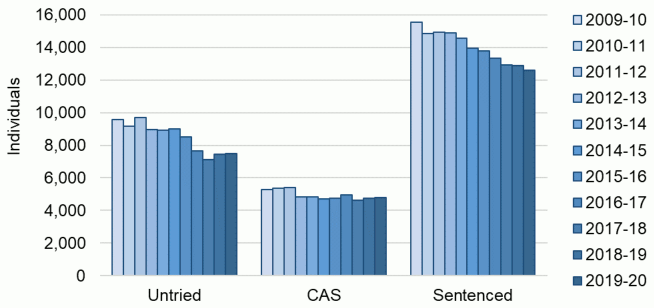
While there has been an overall decrease, there was a slight rise in individuals held in custody as untried and convicted awaiting sentence (CAS in the chart) from 2017-18 to 2019-20 (from 7,114 to 7,509 for untried and from 4,632 to 4,786 for convicted awaiting sentence).
2.1.1 Gender
Both men and women have seen an overall reduction in the number of individuals spending time in custody across each legal status. However, the recent rise in numbers held as untried and convicted awaiting sentence is more pronounced for men, and only observed in 2017-18 for women (Figure 7).
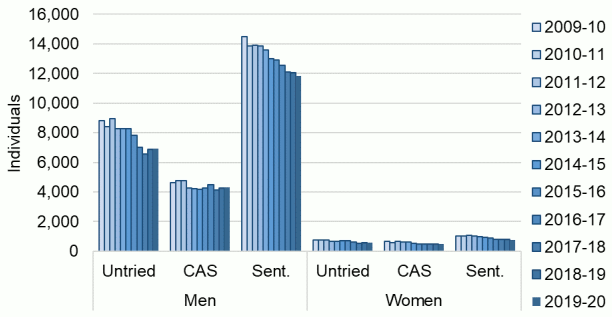
The percentage reduction in the number of individuals held each year is greater for women than men. This pattern holds across each legal status: the percentage reduction for numbers held as untried is 21% and 24% for men and women respectively; as convicted awaiting sentence 7% and 29% respectively; and as sentenced 18% and 28% respectively.
2.1.2 Age
Differences are also observed between age categories. The overall downward trend in numbers of individuals held by legal status appears to have been driven entirely by reductions in the number of individuals in the younger age groups. Up to and including the ‘25-29 years’ group, each age group shows a substantial reduction in the numbers of individuals held in custody in each year. This is particularly pronounced for the ‘16-17 years’ and the ‘18-20 years’ groups (Figure 8).
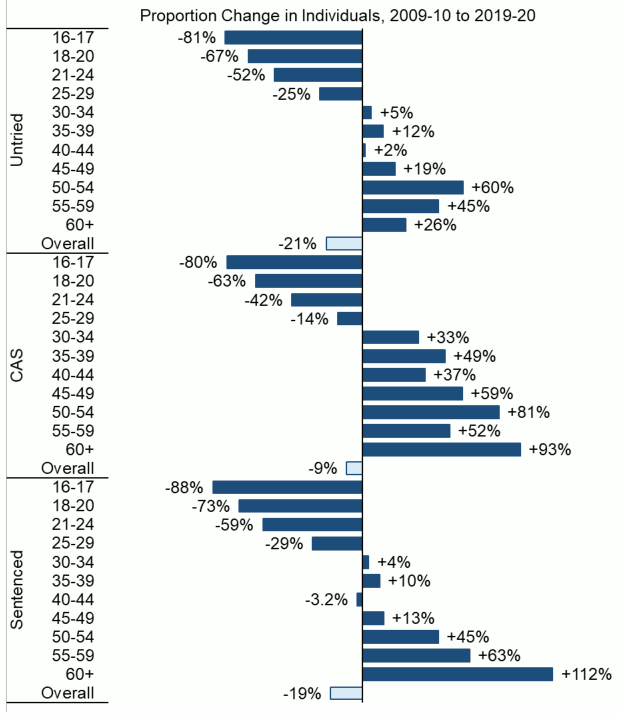
However, each age group from ‘30-34 years’ and above shows a very different pattern, demonstrating either observable stability over the time period examined or increases in the numbers of individuals held in custody across the legal status types.
Across all of the older age groupings, the number of individuals held as convicted awaiting sentence has increased substantially (by around 33% for ’30-34 years’ and almost doubling for ‘60+ years’).
The middle age groupings from ’30-34 years’ to ’40-44 years’ have shown very little change in the numbers of individuals held as untried or sentenced, but the older age groups (particularly ‘50-54 years’ and above) have shown substantial increases in the numbers of individuals in the same categories. The numbers of individuals held as sentenced in the ‘60+ years’ group has more than doubled between 2009-10 and 2019-20, rising from 264 to 533.
2.1.3 Ethnic group
There are different trends across the ethnic groups as well. There have been clear reductions in the numbers of individuals identifying as ‘African, Caribbean or Black’, ‘Asian, Asian Scottish or Asian British’ and ‘White’ across each of the legal statuses. These changes are most pronounced for the ‘Asian, Asian Scottish or Asian British’ groups, and for the legal status of untried.
While the overall numbers are small, there have been observable increases in the numbers of individuals identifying as ‘Mixed or multiple ethnic group’ or ‘Other ethnic group’. These statistics are provided in the accompanying table M1.
2.2 Arrivals
An arrival is where a period of imprisonment begins for an individual, and is only counted as such if the arrival occurred on a separate day from any previous departure for that individual. Overall numbers of arrivals in each year fell between 2010-11 and 2019-20[10], and the fall in arrivals was more pronounced than the fall in the number of individuals, at around 31% (falling from 20,721 to 14,324) compared to 15%.
Analysis by legal status on first point of entry for each arrival in each year reveals two key patterns. Firstly, that arrivals as untried consistently account for just over half of all arrivals to custody in any given year from 2009-10 to 2019-20, a proportion that has risen over the time period (50% in 2009-10 to 56% in 2019-20). Arrivals as convicted awaiting sentence accounted for 18-20% of all arrivals from 2009-10 to 2015-16, rising to 22-23% for 2016-17 to 2019-20 (Table 1).
Arrivals to the sentenced population account for a decreasing proportion of all arrivals over the time period considered. From 2009-10 to 2018-19, sentenced arrivals comprised between a quarter and 30% of all arrivals to custody. This had fallen to 21% by 2019-20; meaning that 79% of all arrivals in 2019-20 were to the remand population.
| Year | 2009-10 | 2010-11 | 2012-13 | 2014-15 | 2015-16 | 2016-17 | 2017-18 | 2018-19 | 2019-20 |
|---|---|---|---|---|---|---|---|---|---|
| Count of Arrivals | |||||||||
| Untried | 10,613 | 10,403 | 9,907 | 9,926 | 9,476 | 8,312 | 7,817 | 8,116 | 8,014 |
| CAS | 4,138 | 4,121 | 3,343 | 3,488 | 3,465 | 3,734 | 3,356 | 3,478 | 3,232 |
| Sentenced | 6,376 | 6,034 | 5,691 | 5,035 | 4,839 | 4,274 | 4,045 | 3,848 | 2,970 |
| Unknown | 159 | 163 | 130 | 91 | 125 | 126 | 106 | 153 | 108 |
| Arrivals | 21,286 | 20,721 | 19,071 | 18,540 | 17,905 | 16,446 | 15,324 | 15,595 | 14,324 |
| Proportion of Arrivals | |||||||||
| Untried | 50% | 50% | 52% | 54% | 53% | 51% | 51% | 52% | 56% |
| CAS | 19% | 20% | 18% | 19% | 19% | 23% | 22% | 22% | 23% |
| Sentenced | 30% | 29% | 30% | 27% | 27% | 26% | 26% | 25% | 21% |
| Unknown | 1% | 1% | 1% | 0% | 1% | 1% | 1% | 1% | 1% |
The second key pattern is the variation from the overall downward trend by legal status. Arrivals for each legal status have declined, but by varying degrees. As Figure 9 shows, the number of arrivals to the sentenced population has fallen consistently and substantially between 2009-10 and 2019-20 (from 6,376 to 2,970, a fall of around 53%)
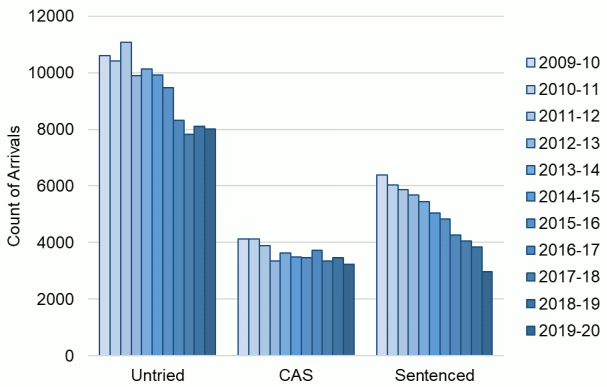
The number of arrivals with untried legal status has also fallen overall (by around 24% from 10,613 in 2009-10 to 8,014 in 2019-20). However, as Figure 9 shows, there has been more fluctuation year to year. While there was a sustained decrease from 2013-14, the number of untried arrivals began to rise again in 2018-19. The number of untried arrivals has remained broadly stable in 2019-20. Similarly, the number of arrivals with convicted awaiting sentence legal status has also fallen overall (by around 22%), but with fluctuation year on year.
2.2.1 Deprivation
Between 2010-11 and 2019-20, the 10% most deprived areas were over-represented in prison arrivals by a factor of three. The least deprived 60% of areas (group 5 and above) were under-represented by increasing degrees as area deprivation decreased. [11]
A full breakdown of this pattern by legal status is provided in supplementary table O1, showing similar over-representation by legal status. However, as a proportion of arrivals by deprivation, those from more deprived areas do not appear more likely to arrive as untried but slightly more likely to arrive as convicted awaiting sentence than those from the least deprived areas (as shown in Figure 10).
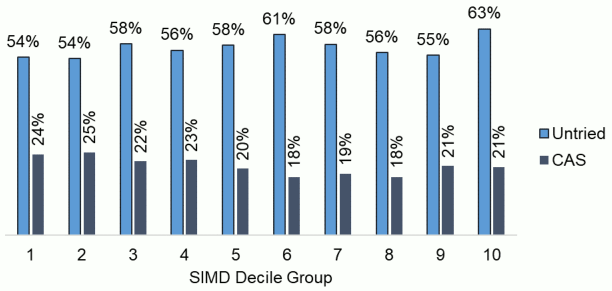
2.2.2 No fixed abode
The proportion of arrivals in to custody where the individual was of ‘no fixed abode’ had rose from 2010-11 to 2019-20 (from 4.4% to 7.5%)[12]. Figure 11 compares arrivals from ‘no fixed abode’ against those from a given address to see if these vary by legal status. Across both categories, the likelihood of an arrival being untried has increased between 2016-17 and 2019-20. However, with the exception of 2014-15, the proportion of arrivals as untried is greater amongst those from ‘no fixed abode’. The difference in proportion is small (between 2 and 6 percentage points in any given year) but the pattern is consistent.
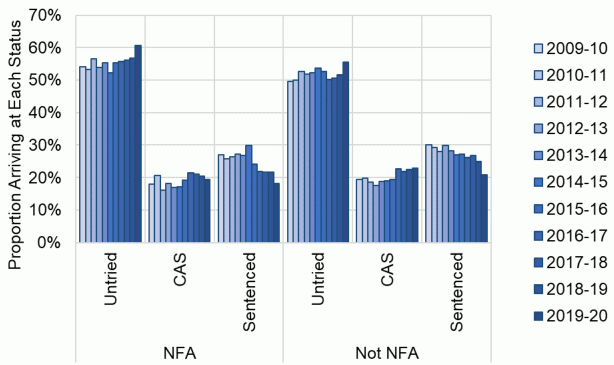
Contact
Email: jamie.robertson@gov.scot
There is a problem
Thanks for your feedback